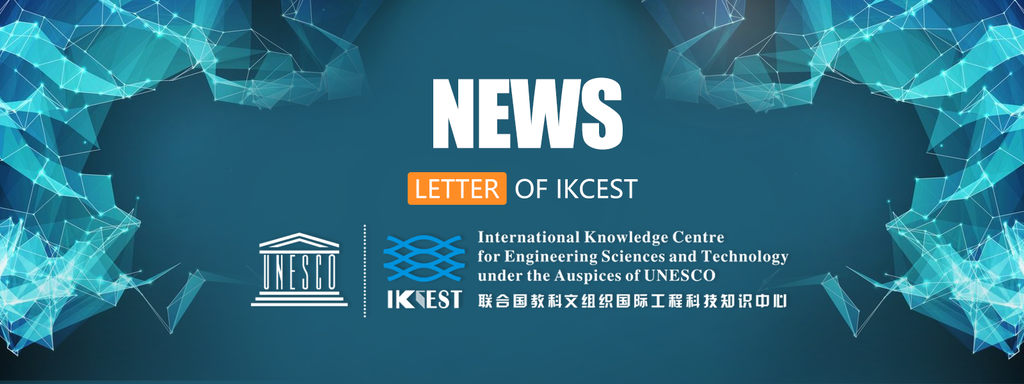
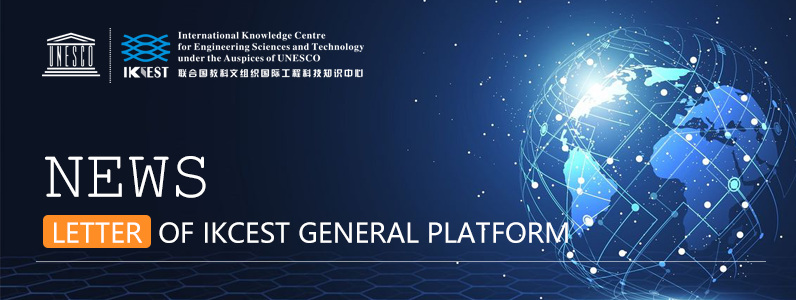
Knowledge application (知识应用)
Academic Conference Video
Introduction: Academic Conference Video is an academic report video streaming platform, jointly built by IKCEST and CKCEST (China Knowledge Centre for Engineering Sciences and Technology), providing online video service to technology personnel and social public. It gives users who have not been in the venue easy access to the high-end academic video resources. The videos are mainly based on academic conferences held by the Chinese Academy of Engineering.
Source: IKCEST General Platform
Release date: Aug , 2019
Provided by: Cai Lingli , Zhang Xinxing

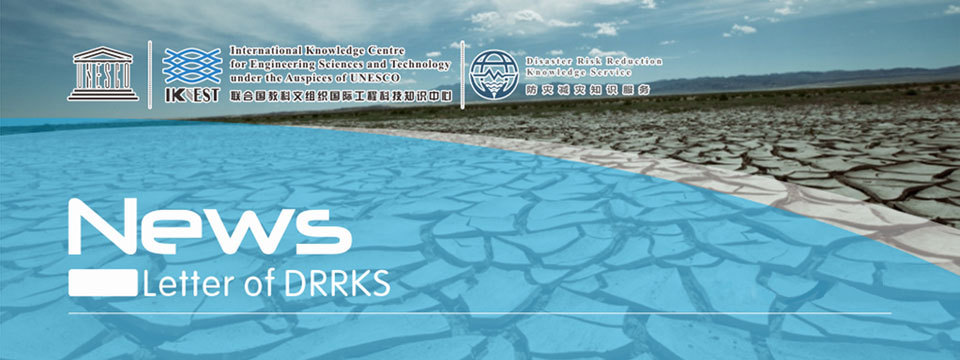
Scientific Data (科学数据)
Monthly maximum temperature monitoring data set for south and southeast Asia(1989-2018)(东南亚和东南亚的每月最高温度监测数据集(1989-2018))
Introduction: The data set is calculated and interpolated by weather station data. The meteorological site data comes from NOAA, which includes data such as temperature, wind speed, and precipitation. The research team processes the daily weather station data into monthly data, and then interpolates through Kriging to form raster data covering the entire study area.
Source: Disaster Risk Reduction Knowledge Service
Release date: Sep , 2019
Provided by: Yuan Yuelei
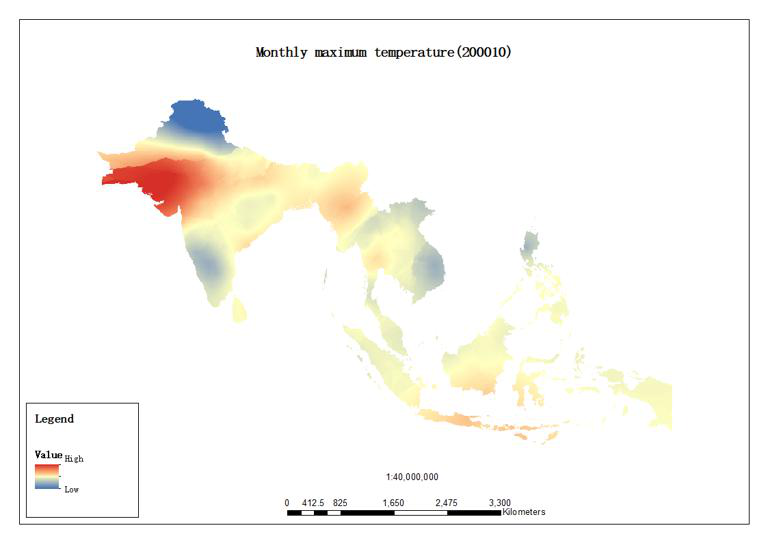
Bangladesh, China, India and Myanmar's historical drought datasets of 1981- 2018(1981-2018年孟中印缅历史干旱数据集)
Introduction: This dataset is acquired from Google news, Wikipedia, the Emergency Events Database and reference documentation by data crawl, collecting and arranging, which describes some drought information about year, disaster type, country, total deaths, injured, et al. And the dataset counts the drought event occurred in Bangladesh, China, India and Myanmar from 1981AD to 2018AD, which includes 38 data in total. This dataset can help user to know the temporal and spatial distribution of drought occurrence, and provide strong support for some drought prevention and mitigation and related scientific research.
Source: Disaster Risk Reduction Knowledge Service
Release date: 2018
Provided by: Yuan Yuelei
Knowledge application (知识应用)
Knowledge Service of the Spatio-temporal Distribution of Major Historical Disasters in China-Mongolia-Russia Economic Corridor(中蒙俄经济走廊重大历史灾害时空分布的知识服务)
Introduction: The natural geography of the China-Mongolia-Russia economic corridor is complex and diverse, the ecological environment is fragile and sensitive, and desertification is a serious problem. This knowledge service application is to diagnose the pattern and change of desertification along the China-Mongolia railway (Mongolia section) from 1990 to 2015. This knowledge applied the object-oriented remote sensing image interpretation method to obtain the desertification data with a resolution of 30 meters within 200 kilometers on both sides of the China-Mongolian railway (Mongolia section) in 1990, 2010 and 2015 for the first time. It can be used to study the risk assessment of desertification in China-Mongolia railway, providing an important basis for preventing sandstorms, floods and other disasters caused by desertification and alleviating the negative impact of desertification.
Source: Disaster Risk Reduction Knowledge Service
Release date: 2018
Provided by: Yuan Yuelei
Video (视频课件)
Disaster Risk Reduction and Development Safety in the context of SDGs--IRDR perspectives(可持续发展目标下的灾害风险降低和发展安全——IRDR视角)
Introduction: Disasters are increasing globally. The Asian region suffers the maximum impacts of the disasters in terms of the numbers of affected people as well as human and economic losses. The Sendai Framework for Disaster Risk Reduction 2015-2030 was adopted at the Third UN World Conference on Disaster Risk Reduction to prevent new, and reduce existing risk and to strengthen resilience to natural and man-made hazards, in order to achieve substantial reductions in disaster losses. This international commitment is also marked in both the Agenda 2030 for Sustainable Development and the Paris Agreement on climate change, thus disaster risk reduction has become an integral part of global effort to pursue sustainable development goals (SDGs). Disaster prevention and risk reduction should be recognized as critical issue of development safety, and be reflected in the overall national development policy.
Source: Disaster Risk Reduction Knowledge Service
Release date: 2019
Provided by: Yuan Yuelei
Sharing Biodiversity Data in Global, Regional and National Level(在全球、区域和国家层面共享生物多样性数据)
Introduction: The earth is experiencing a dangerous status because of the faster and faster speed of biodiversity losses. The management and sharing of biodiversity data is the basis and pre-condition of biodiversity protection. From the global view, the example projects of CoL(Catalogue of Life), GBIF(Global Biodiversity Information Facility), EOL(Encyclopedia of Life), BHL(Biodiversity Heritage Library) and BOLD Systems had paved a good basis of biodiversity research. And other projects like WDPA(World Database on Protected Areas) and IUCN Redlist gave other thematic biodiversity data. These portals also provide some tools and APIs which made data application and sharing easier. In China, biodiversity data are distributed in different portals funded by Ministry of S&T, Chinese Academy of Sciences and different institutes. In recent years, more and more collaborative international or regional projects are carried out, for example the MAP(Mapping Asia Plants). China will play an important role in the collaborative activities in the Asia and One Belt and One Road area.
Source: Disaster Risk Reduction Knowledge Service
Release date: 2019
Provided by: Yuan Yuelei


Scientific Data (科学数据)
Latest Global CityIQ Ranking(最新全球城市IQ排名)
Introduction: The statistical data are acquired from a variety of governmental and third-party sources. Intelligent Knowledge Service System uses advanced simulation models to fill the missing data. 2.Web Crawling Data: Tools were built to capture the data upon keywords from trusted cities’ official websites. The data will be transformed and used for the indication. 3.Survey data: Surveys are conducted using questionnaires concerning several key issues of sustainable development, corresponding to the 5-dimensional evaluation system. 4.Public Opinion Analysis: Based on the CityIQ database, we have added a sub-database, the City Public Opinion Analysis Database(CPOAD). The CPOAD obtains a large amount of public opinion analysis data from online social media to ensure the database upgrading dynamically and accurately.
Source: Intelligent City Knowledge Service
Release date: Nov , 2019
Provided by: Cao Buyang

Knowledge application (知识应用)
Regeneration Projects of Nantes Island (南特岛更新项目)
Introduction: The project is located in the middle of the island, far from the river Loire, in a suburban zone with social housing and factories. Directed by Alexandre Chemetoff since 1990, the project is the transformation of a long unused factory and warehouse district into a large working and housing neighborhood of 350 hectares.
Source: Intelligent City Knowledge Service
Release date: Nov , 2019
Provided by: Eurocities
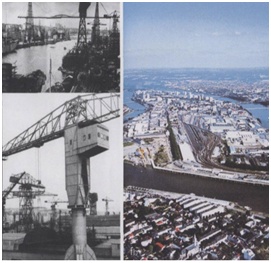
PlanIT Valley, Porto, Portugal (规划IT谷)
Introduction: From 2006, a city built from scratch just east of Porto, PlanIT Valley willsimultaneously serve as a testing platform for partner companies, smarttechnologies, innovation centers, and incubators for technology start-ups.Using the company's unique Urban Operating System™ (UOS), Living PlanIT will manage daily processes and gather data via hundreds of millions of 'smart' sensors deployed throughout the city.
Source: Intelligent City Knowledge Service
Release date: Dec , 2019
Provided by: Wang Yueqi

Singapore Waste Management (新加坡废物管理)
Introduction: With waste quantities projected to continue increasing with growing affluence and population, Singapore's main challenge in solid waste management is the setting aside of land for waste disposal in view of the limited land stock in Singapore.
Source: Intelligent City Knowledge Service
Release date: Dec , 2019
Provided by: Shi Xiaochen
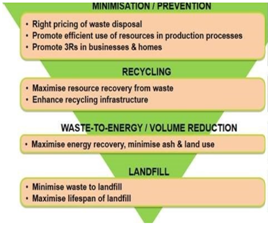
Video (视频课件)
Urbanization and Construction of Ecological Civilization (城镇化与生态文明建设)
Introduction: Environmental problems brought by development and some viewpoints on the relationship between environmental protection and development in the process of development.
Source: Intelligent City Knowledge Service
Release date: Nov , 2019
Provided by: He Rui

Big data and urban space research (大数据与城市空间研究)
Introduction: The arrival of the era of big data means that by collecting, processing, analyzing and developing the data of residents' daily behaviors or activities through smart phones, social networks and other devices, residents can have an in-depth understanding of their concerns, find out the urban problems that need to be solved, and guide and serve residents intelligently.
Source: Intelligent City Knowledge Service
Release date: Nov , 2019
Provided by: He Rui

Intelligent-intensive Urbanization vs Labor-intensive Urbanization (智慧密集型城镇化VS劳动密集型城镇化)
Introduction: Wu Zhiqiang thinks urbanization is bound to be completed, but urbanization is divided into two roads, and at present, urbanization is coming.
Source: Intelligent City Knowledge Service
Release date: Dec , 2019
Provided by: He Rui
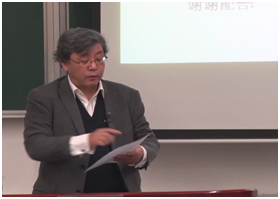

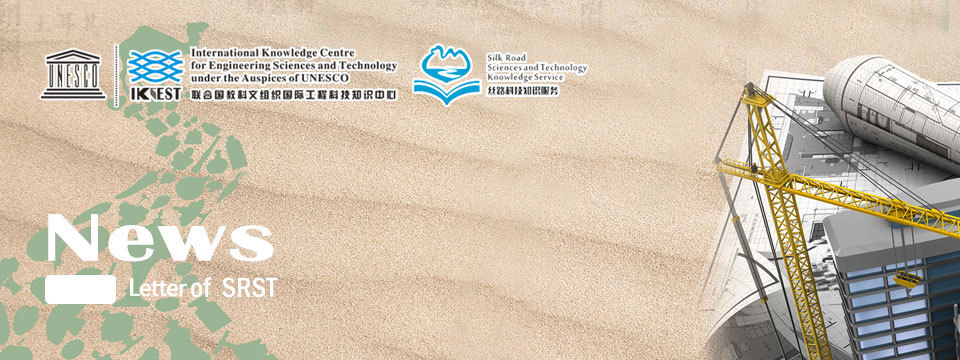
Scientific Data (科学数据)
Chinese comprehensive database(中国综合数据集)
Introduction: This data collection brings together relevant information resources of China. The content of the subject gathers literature on trade, commerce, economy, investment, literature, art, humanities, geography, etc. The types of documents include journals, conferences, books, dissertations, standards, etc. This data collection serves experts and scholars, enterprises and college students in the fields of education, science and technology, culture, etc. It aims to promote all-round exchanges and cooperation, serve national development, explore new mechanisms of transnational training and cross-border flow of talents, and cultivate high-quality talents with an international perspective.
Source: Silk Road Sciences and Technology Knowledge Service
Release date: Oct , 2019
Provided by: Zhu Ying
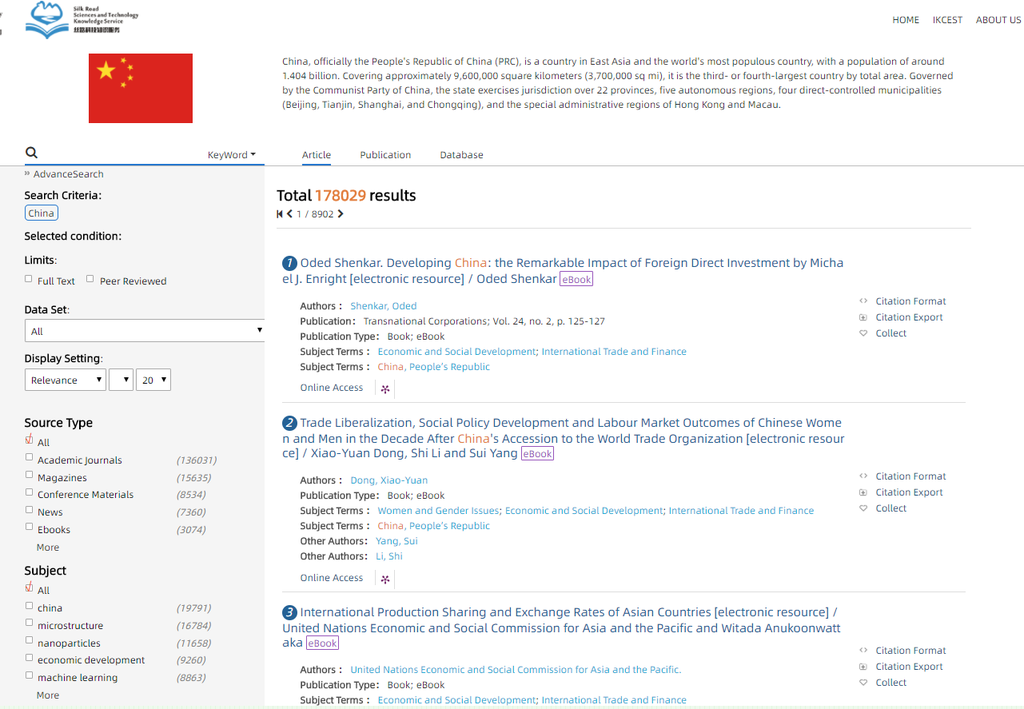
Knowledge application (知识应用)
The World Rank of Chinese Universities(“一带一路”高校排名-中国)
Introduction: A knowledge application for comprehensive display and inquiry of Chinese universities is built to comprehensively display four internationally recognized world university rankings, such as QS, THE, US News and soft science world university rankings, so as to facilitate engineering and scientific personnel from countries along the " Belt and Road" to recruit students and choose schools in countries along the " Belt and Road".
Source: Silk Road Sciences and Technology Knowledge Service
Release date: Oct , 2019
Provided by: Zhang Qianglong
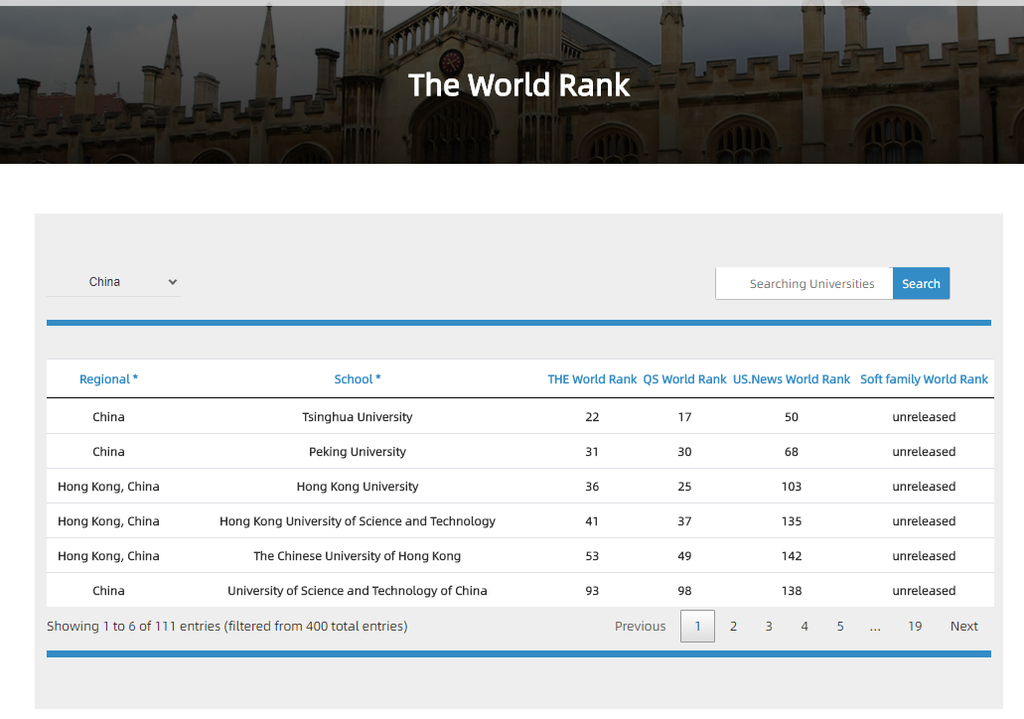
Video (视频课件)
Internal medicine common emergency(内科常见急症)
Introduction: The disease systems involved in this course are divided into four chapters: digestive system, nervous system, respiratory system and first aid technology. The course is based on the principle of “moderate theory and practicality”. It is as important as possible, with the distinction of primary and secondary, combined with illness, and the theory closely related to daily life. It reflects the characteristics of letting the public understand and highlighting the popularity of health, let us be in life. Learn about the symptoms of the disease you often encounter.
Source: Silk Road Sciences and Technology Knowledge Service
Release date: Oct , 2019
Provided by: Liu Jun



Scientific Data (科学数据)
Academic Trend Database
Introduction: Click on the "Academic Trend" icon on the homepage to enter the academic dynamic database page. Then click on the field you want to visit, such as "Artificial Intelligence", to get the development history, research hotspots and trends of the corresponding field.
Source: Engineering Education Knowledge Service
Release date: Dec , 2019
Provided by: Tian Huijun , Li Zhengwen

Knowledge application (知识应用)
Micro-Diploma of Computer Science 2020
Introduction: Micro-Diploma of Computer Science includes "Data Structures and Algorithm Design" , "Data Mining: Theories and Algorithms for Tackling Big Data"," Combinatorial Mathematics" and " Computational Geometry", four courses. Users can Learn through these core curriculums of Computer Science, quickly reach the vocational requirements of a particular field and get a new career boost.
Source: Engineering Education Knowledge Service
Release date: Dec , 2019
Provided by: Tian Huijun , Li Zhengwen

Video (视频课件)
Circuits and Electronics I(电路和电子学I)
Introduction: The course introduces engineering in the context of the lumped circuit abstraction. Topics covered include: resistive elements and networks; independent and dependent sources; switches and MOS transistors; digital abstraction; amplifiers; energy storage elements; dynamics of first- and second-order networks; design in the time and frequency domains; and analog and digital circuits and applications. Design and lab exercises are also significant components of the course. The course is organized by weeks. To keep pace with the class, you are expected to complete all the work by the due dates indicated. Homeworks and labs must be completed by the Sunday of the week following the one in which they are posted. Weekly coursework includes interactive video sequences, readings from the textbook, homework, online laboratories, and optional tutorials. The course will also have a midterm exam and a final exam. Those who successfully earn enough points will receive an honor code certificate from MITx.
Source: Engineering Education Knowledge Service
Release date: 2019
Provided by: Tian Huijun , Li Zhengwen

Will China Rise as a Disruptive Force? The Insiders’ Perspective (中国大国崛起的经济、历史、国际研究分析)
Introduction: China, one of the world’s oldest countries, is currently undergoing massive political, social and economic changes. The rapid emergence of China as a key player in the global political and economic landscape has led many to question how China’s decision makers perceive today’s world. What are their views on major global affairs? How does Chinese history and philosophy shape their outlook of the world? What are the prospects for China’s future economic growth? This course helps learners understand the rise of modern China from an insiders’ perspective with insight from three of China’s leading social philosophy, international relations and economic experts.
Source: Engineering Education Knowledge Service
Release date: 2019
Provided by: Tian Huijun , Li Zhengwen
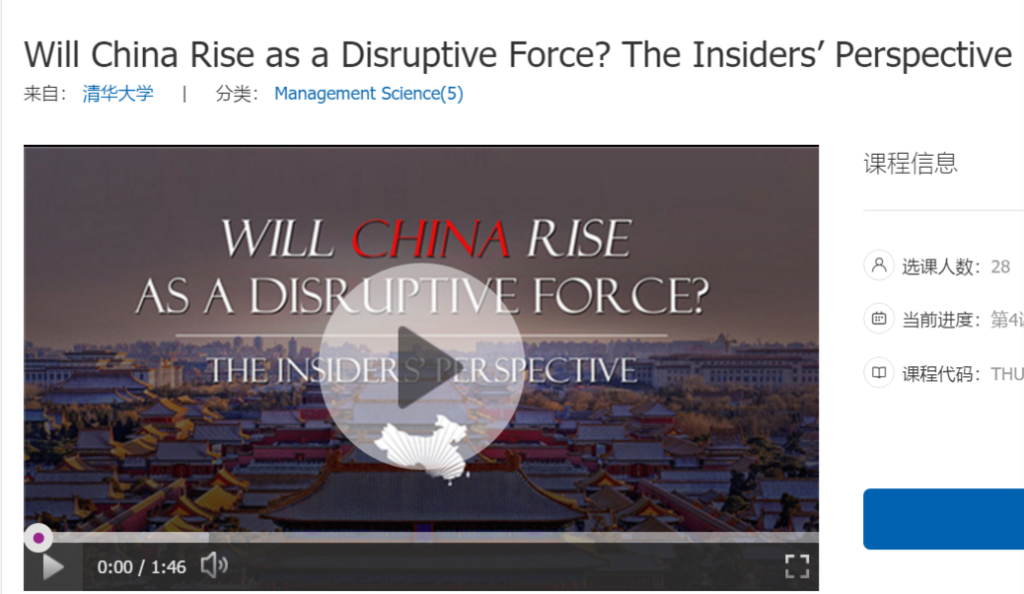
Entrepreneurship 101: Who is your customer? (创业101:你的客户是谁?)
Introduction: Entrepreneurship 101 prepares you for the MIT Global Entrepreneurship Bootcamp! The Bootcamp is a one-week, intensive entrepreneurship education program that challenges you to start a company in 5 days. The Bootcamp offers you the unique opportunity to be mentored by MIT faculty and MIT alumni entrepreneurs and investors as you begin your new entrepreneurial journey. This course is not only for those planning to attend the Bootcamp. If you have a business idea and don't know how to move forward, this course will help you immeasurably whether you continue to the Bootcamp or not. As you’ll learn in this course, to go from idea to business, you’ll need a paying customer. Sound daunting? It’s OK – there is a systematic methodology for you to get a paying customer. Specifically, upon completion of Entrepreneurship 101, you’ll have the skills to: Conduct Market Segmentation Select your Beachhead Market
Source: Engineering Education Knowledge Service
Release date: 2019
Provided by: Tian Huijun , Li Zhengwen

Entrepreneurship 102: What can you do for your customer? (创业102:你能为客户做什么?)
Introduction: Entrepreneurship 102 prepares you for the MIT Global Entrepreneurship Bootcamp! The Bootcamp is a one-week, intensive entrepreneurship education program that challenges you to start a company in 5 days. The Bootcamp offers you the unique opportunity to be mentored by MIT faculty and MIT alumni entrepreneurs and investors as you begin your new entrepreneurial journey. This course is not only for those planning to attend the Bootcamp. If you are beginning to design a product or service to meet your customers needs, this course will point you in the right direction whether you continue to the Bootcamp or not.
Source: Engineering Education Knowledge Service
Release date: 2019
Provided by: Tian Huijun , Li Zhengwen


>>>IKCEST Newsletter 2019 October<<<
>>>IKCEST Newsletter 2019 August<<<
>>>IKCEST Newsletter 2019 June<<<









 User Center
User Center My Training Class
My Training Class Feedback
Feedback






